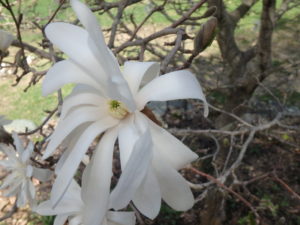Magnolias for New England
One of my yearly high points occurs when my Merrill magnolia blooms. This year, and most years, mine blooms on my birthday, April 23. This year it opened that afternoon; some years it starts a week earlier and is fully in blossom; once or twice it has held off until May. Only once in 25 years has it failed to put on a great show, when there was a hard frost just before the buds were to open.
The Merrill magnolia is a “Loebner” hybrid, created by crossing the star magnolia (Magnolia stellata) with a Kobus magnolia. There are many Loebner varieties, and most are hardy from Zone 4 or 5 to 7 – fine for all of New England. Mine is white, with a soft light pink stripe on the outside of the petals (though technically they are tepals, not petals). And the blossoms are large – 4 inches or so – and fragrant. What more could you want? Other Loebner hybrids are pink or dark pink.
The Merrill magnolia does best in full sun and rich, moist soil. The literature says it needs well drained soil, but mine has thrived near my brook. The water table is near the soil surface all winter and spring, and only a couple of feet down in a dry summer. So I was not at all sure that mine would succeed. In the twenty years or so since I planted a 4-foot tall specimen, it has grown to an estimated 40 feet tall and 30 feet wide.
It really is a 4-season tree. The leaves are handsome all summer, turning a nice yellow in fall, and the flower buds are large and furry all winter, like pussy willows on steroids.
I also have a smaller magnolia, a cultivar named ‘Jane’, that blooms later and stays smaller than my Merrill. It is one of the “Little Girl Hybrids”, a cross between a Magnolia liliiflora and M. stellata. Jane only gets to be 12 feet or so tall, and perhaps as wide. Her blossoms are deep pink in bud, and whitish inside when open. Like the Merrill, the leaves are shiny, glossy and beautiful.
One of Jane’s best characteristics is that she re-blooms throughout the summer and into the fall. Not a lot of blossoms, but a few. Just enough to make me stop in my tracks and exclaim every time I see a blossom. But frankly, the buds are better than the blossoms – perfect, each one. But the blossoms often develop a brown color once they open.
The star magnolia is a species magnolia, not a hybrid. It stays smaller than my big Merrill – perhaps to 15 or 20 feet tall and nearly as wide. So for smaller landscapes, it is a good choice. It is rated at hardy to Zone 4, but some grow in Zone 3. The blossoms are white, and come earlier than the Merrill – so they can be damaged by late frosts. There are single blossoms and double blossoms with extra petals.
Then there is the saucer magnolia (Magnolia x soulangiana). These are rated as Zone 4, but are most successful in Zone 5 or warmer. They are small trees, to a height of about 25 feet. The blossoms are amazing: up to 10 inches across in white, pink or purplish. Unfortunately, they bloom early and are often devastated by frost. These are commonly planted in Boston, probably because the heat of the buildings protects them against frost damage.
A neighbor of mine has a cucumber tree magnolia (Magnolia acuminata). This can get to be a huge tree – 50 to 80 feet tall. It is fast growing, perhaps 10 to 15 feet in six years. Its distinguishing characteristic, aside from size, is that is has yellow blossoms. Unfortunately, the blossoms are generally near the top of the tree, and can be masked by foliage. It does not do well in very dry or very wet soils, but will grow in full or partial sun.
When I interviewed the White House gardener many years ago I asked about the two huge southern magnolias (Magnolia grandiflora) that frame the back of the White House. They are magnificent. Dale Haney, the head gardener, told me that President Andrew Jackson brought them up from Tennessee as tiny saplings, on horseback. He planted them in 1830 in memory of his late wife and they have survived and thrived for nearly 200 years.
The southern magnolia is only hardy to Zone 6 or 7, so I can’t grow one here. Too bad. The flowers are 8 to 12 inches across, creamy white and superbly fragrant. But the trees grow to be 50 to 80 feet tall – and live forever, it would seem. They bloom in May or June.
Magnolias, in general, have fleshy roots and few root hairs. They do not transplant well, once established. So find the proper place before digging the hole. As with any tree, do not plant them too deep.
In nature, tree trunks flare out at the soil line. This trunk flare should never be buried at planting time or the bark, if covered with soil, will rot and destroy the cambium layer and eventually kill the tree. Many trees come from the nursery with the trunk flare buried, and it is important to remove the soil from the trunk flare before planting.
If could only bring one tree with me to a remote island, I suppose I’d have to take an apple tree for the food. But for beauty? I’d take a magnolia.
Henry Homeyer is the author of 4 gardening books.





